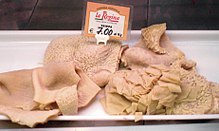Tripe

Tripe , stains or tripe (in Baden Sulz , in Saarland Flauzen , in Saxony also called Piepen , in parts Frankens Schnickerli ) are the kitchen-language names for the rumen of ruminants, which is usually cut into strips . They belong to the innards . In addition to tripe from domestic sheep and from self-eating beef calves ("eater"), tripe from domestic cattle is mainly used.
distribution

Tripe is eaten in many countries, in the German-speaking area mainly in southern Germany, Saxony, Austria and Switzerland. They are still an integral part of culinary culture in Italy, France, Spain, Turkey, and Southeastern Europe, although consumption has declined since the 1980s. They are made into ragouts , stews and soups or eaten fried as a main course. In Portugal, the dobrada , a bean stew with tripe, is a popular dish. In Romania and Moldova, the ciorbă de burtă is one of the national dishes and, like Schkembe tschorba , is a popular soup in Bulgaria. It is served with thick sour cream, garlic and hot peppers. In Bulgaria, the tripe is also eaten as the main course, fried in a pan and mixed with the tongue. This mixture is also obtained in an earthen serving bowl baked with cheese. There is a variety of dishes. In Hungary the tripe is cooked as tripe goulash, sometimes with the brain, and is eaten as a hearty meal in the pub. In Poland, tripe soup (flaki or flaczki) is also served at festivals.
Processing and dishes
To make them edible, tripe must be thoroughly cleaned, freed from adhering sebum, soaked for several hours and finally cooked in salt water for about ten hours. Cooking time can vary widely and depends on the age of the animal. Tripe prepared in this way are available from butchers in southern Germany and can be further processed according to a recipe. Uncleaned “green” tripe make good dog food , but have a very unfamiliar smell of cowshed for humans.
In addition to the rumen, the other three stomachs of the cow are also processed into tripe in Italy and France: reticulated stomach , leaf stomach and abomasum .
Well-known tripe dishes are sour tripe , Tripes à la mode de Caen , Tripas à moda do Porto , Trippa alla fiorentina , Lampredotto , Callos a la Madrileña , Morzello (Morzeddhu alla catanzarese) and tripe soup . Variants of tripe soup are among the specialties of different countries. Sausage preparations with tripe are also available in French butchers (e.g. andouillette ). The Italian mortadella also contains tripe.
etymology
The Middle High German word kutel , meaning “entrails of animals”, has been attested since the 13th century, but its further origin is unclear.
The term "tripe" has its origin in the vulgar Latin calduna ('still warm entrails'), from which the tripe became in German via Middle High and Middle Low German kaldune . Tripe originally referred to all edible innards of slaughtered animals, not just the actual tripe. In the past, poor students who received free meals made from cheap ingredients by charities were disparagingly referred to as tripe eaters .
Web links
Individual evidence
- ^ Aux meilleures tripes de Paris , Le Monde, October 16, 2008, p. 28
- ↑ Tripe belong in mortadella
- ↑ Duden: dictionary of origin. Mannheim 2007, Lemma Kutteln. (Compare the Icelandic word kviður for "stomach")
- ↑ Kaldaune in the online edition of Duden - The great foreign dictionary: origin and meaning of foreign words. Mannheim, Leipzig, Vienna, Zurich: Dudenverlag 2003.
